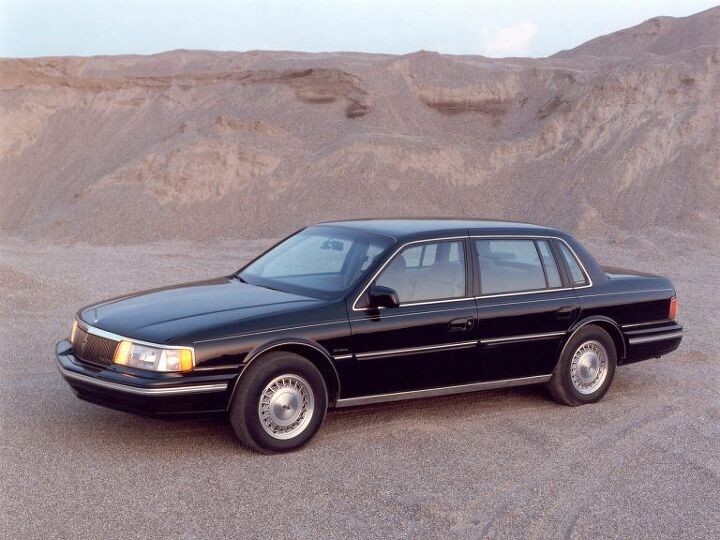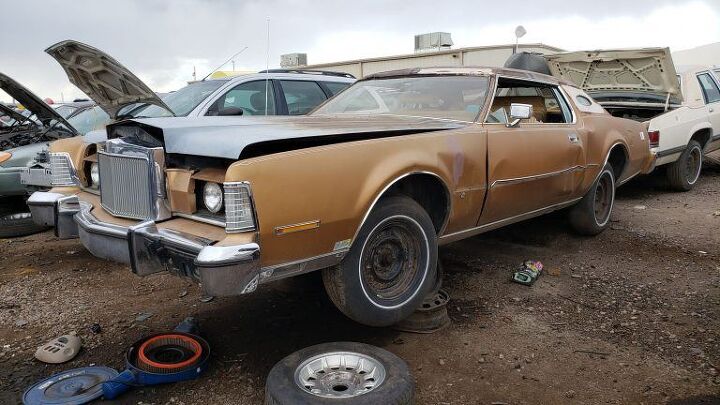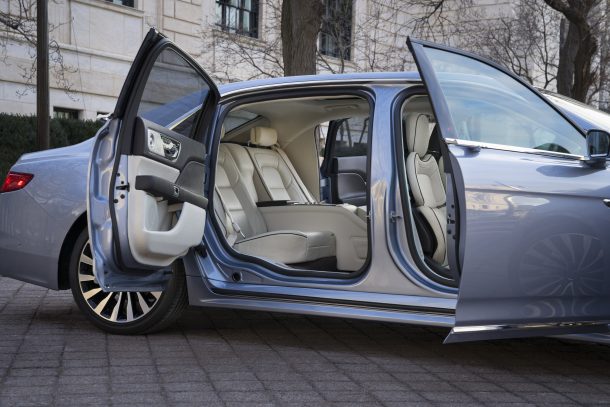#Continental
Ace of Base: 2020 Lincoln Continental Standard
Long-time readers (thanks, all three of you) may recall a certain, erm, affinity at this site for vehicles from the old Lincoln-Mercury stable. Sajeev shed many bitter tears over various Cougars and Marks found in our nation’s junkyards, while your author freely admits he suffers an odd form of Stockholm Syndrome. And the world turns.
It’s difficult to pin down just how much time the Continental has left on this mortal earth, with the Blue Oval suits pulling the plug on everything with a trunk in Ford’s showroom. Production changes at Flat Rock surely spell its death by 2021 to make room for EVs, but, for now, it remains.
Get Yer Coach Doors While You Can
Not many of you will, of course, and not just because the Lincoln Continental Coach Door Edition now sells for more than $115,000. There’s too few of them, you see.
Last year’s surprise run of coachbuilt, suicide-doored Continentals sold out in 48 hours and totalled just 80 vehicles. For 2020, the fabulously expensive long-wheelbase Conti stages what might be its last appearance, offering a greater likelihood of scoring a buy.
Buy/Drive/Burn: $60,000 Luxury Sedans in 2020
Say you’re an auto shopper of wealth and taste who has around $60,000 to spend. Now, let’s assume the usual options from Japan and Germany are not for you. Would you turn to America or Sweden to fill your luxury needs?
Buy/Drive/Burn: Floaty American Luxury Sedans From 1988
In the late Eighties, American auto manufacturers still sold large, traditional luxury sedans in decent numbers. Their aging sedan consumer base fondly remembered the vinyl and chrome of yesteryear and still relished brougham-style accoutrements.
Up for consideration today are three comfortable, luxury-oriented sedans from 1988. It’s hard to lose here.
Junkyard Find: 1974 Lincoln Continental Mark IV
Big, Detroit-made Malaise Era personal luxury coupes still keep showing up in the big self-service wrecking yards, more than 35 years after the last one rolled off the assembly line. Yes, the diminished-expectations Mark VI, the “What Oil Crisis?” Mark V, and the rococo Mark IV— examples of each of these will appear in your local U-Wrench yard from time to time.
Here’s a worn-out Mark IV from the year of Nixon’s resignation and Haile Selassie’s banishment from his throne in a lowly Beetle, now awaiting The Crusher in a Denver yard.
Doors Make the Man: Lincoln's Suicide-doored Continental Proves Exceptionally Popular Among the Well-off Crowd
“Exceptionally popular” is a descriptor that does not jibe well with “Lincoln Continental,” as sales of the division’s flagship sedan haven’t exactly fallen into the category of scorching. Introduced late in 2016 as a 2017 model year vehicle, sales of the Continental fell 3.8 percent, year over year, in December, and 27.1 percent for the entirety of 2018.
While the Continental suffers from a crossover-inflicted illness impacting all cars, one Continental variant has no trouble generating demand: the lengthened, limited-edition Coach Door Edition, which bowed late last year with a price tag of just over $110,000.
People clearly want to be seen exiting from rear doors that open the wrong way.
When Cultures Clash: Coach Door Edition Conti Triggers Folks Worried About Suicide
Considering they’re only making 160 of them, the suicide doors on the eighty Coach Door Edition Lincoln Continentals to be sold next year have garnered quite a bit of attention.
The use of rear-hinged doors on vehicles dates to the horse age. It seems that sometime in the 1930s the moniker “suicide doors” was applied to them, apparently due to people’s propensity for falling out of cars in the decades before Ford introduced the seat belt (as an option in 1956). There’s also, at least according to something frequently reproduced online, a connection with gangsters pushing people out of cars — though to my ears, that would be more like homicide doors.
I’m not convinced, though, it’s any easier to fall (or be pushed) out of a car with such doors, other than the fact that aerodynamics will help keep the door open while you’re falling (or being pushed).
King of Egress: Lincoln Stretches 2019 Continental, Swaps Rear Doors for a Limited Few
It’s true. You’ll soon be able to slap down a pile of hard-earned cash for a 2019 Lincoln Continental with suicide coach-style doors. Well, 80 of you will.
To mark the 80th anniversary of the Continental nameplate, Lincoln Motor Company went the extra mile for heritage devotees, revealing a limited-edition model that dispenses with front-hinged rear doors and adds half a foot of wheelbase to pull it off. You’ve never had a better look at the Continental’s B-pillar.
At What Point Do We Want Our Cars to Be Less Like Our Phones?
That’s one of the unspoken questions contained in Automotive News‘ report on automotive supplier Continental’s new biometric authentication technology. Passwords are the scourge of the modern age, it’s true, and having a secure way of locking and unlocking a sensitive…anything…is preferable to trying to remember that damn combination of letters and numbers.
Computer files. Your phone. The entrance to sterile, high-security office buildings. These are all good candidates for facial recognition technology, fingerprint and retina scans, or voice recognition. But your car? It’s true that using this technology — in addition to conventional keys and fobs — would add an extra layer of defence, improving your vehicle’s chances of remaining unmolested. But at what cost?
MKNothing: Why Lincoln Ditched the Alphabet Soup
The tens of readers who follow my bleatings here on TTAC (Hi, Dad!) may recall my fondness for the Lincoln brand. Having spent my own hard-earned Canadian dollars on two of them, plus encouraging other family members to do the same, I would be lying if I said I’m not rooting for the brand to once again plant its feet firmly in the minds of its target demographic.
For me, the disarmament campaign started when Lincoln began abandoning real names in favor of an alphanumeric (minus the numeric) naming scheme. Turns out, after reading a revealing Automotive News interview with Lincoln’s marketing chief, I’m not the only one who disliked it.
Vellum Venom: Dash-to-Axle, Defined
With reader feedback always on my mind, perhaps an overview of commonly used terms in the car design trade is needed.
Let’s discuss the dash-to-axle: a notion that’s (probably) been a car design staple since Edsel Ford’s vision for an European-inspired flagship — one which added 7 inches to the hood of a mere luxury car.
Ask Jack: What About That American Exceptionalism?
If you’ve been reading me for a while, you know that I’m passionate about obtaining products, goods, and services that are Made In The USA. Which is not to say that I never buy anything from low-cost countries where workplace safety and environmental regulations aren’t up to snuff — to my eternal sorrow, both of my laptops are Chinese, and as many of you have reminded me, the new Silverado LTZ in my driveway was Hecho en Mexico — but in general I will pay a considerable cost in both time and money for an American or at least Western product.
It’s possible, of course, that I’m just doing it to be a total snob. Nowadays, Made In America tends to imply prestige and cost, whether we’re talking SK Tools, Alden boots, or any number of high-end, hand-made bicycles. If you’re walking down the street and everything on or about your person is USA-made, chances are you’ve spent some real money. That’s also true for many industrial goods, certain building supplies, and nearly anything with wings. There’s just one complex product where the American flag logo is attached to a mandatory discount in the minds of most consumers.
No prize for figuring out what that is…
Tread Trends: GM Switches to Artisan Tires Using Sustainable 'Green Rubber'
General Motors has announced it will choose “sustainable natural rubber” for the 49 million tires it buys each year. The automaker claims it is establishing a set of buying principals to ensure sustainably harvested materials and is encouraging other automakers to follow suit in a bid to reduce deforestation.
It won’t suddenly make driving your Chevrolet good for the environment, but it should give drivers bragging rights — allowing them to claim their tires killed fewer critters before even getting the opportunity to run any over.
However, environmental smugness is occasionally warranted. With tire manufactures representing 75 percent of the natural rubber market (according to the World Wildlife Fund), an overall shift toward sustainability would provide a measurable impact on deforestation. But what is General Motors getting out of this move and what will the price of environmental awareness be?
Super Piston Slap: No Free Stuff For You!
Every “How To” automotive series pushes the aftermarket hard for free stuff, even under-the-radar journos like Zach Bowman and Regular Car Reviews find themselves with free/discounted goodies. I’ve done product reviews in TTAC’s past, so this isn’t a Baruthian hit piece on journalistic greed. Heck, Bowman generously donated his pre-sponsorship clutch for TTAC’s Ford Sierra (more on that much later) and Mr. Regular seems like a righteous enough dude.
So instead, think of my work as the alternative to PowerBlock TV. What work is this, you may ask?
Piston Slap: Peeling Ponies and Contaminated Aluminum Hoods
TTAC Commentator Kurt_B writes:
Hi TTAC. I’m a long time reader and member. My four-year-old Mustang hood is peeling. Ford does not cover this issue outside of the three-year comprehensive warranty, and even when repaints are authorized they don’t last. This is a very common issue that has to do with poor paint adhesion to aluminum. I’m pretty sure we’re going to see peeling 2015+ F150s in a few years with their aluminum panels.
For Sajeev: A lot of owners buy aftermarket fiberglass hoods (Cervini, etc). Others have their factory hoods repainted, which may or may not last. One shop I went to suggested vinyl-wrapping the hood — something I really don’t want to do to a four-year-old car.






























Recent Comments